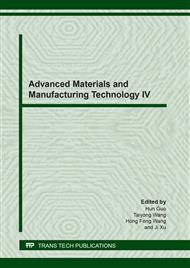[1]
J. H. Jia, H. D. Zhou, S. Q. Gao, et al., A comparative investigation of the friction and wear behavior of polyimide composites under dry sliding and water-lubricated condition, Mat. Sci. Eng. A-Struct. 356 (2003) 48-53.
DOI: 10.1016/s0921-5093(03)00052-2
Google Scholar
[2]
Z. F. Fei, Z. C. Yang, G. B. Chen, et al., Preparation and characterization of glass fiber/polyimide/sio2 composite aerogels with high specific surface area, J. Mater. Sci. 53 (2018) 12885-12893.
DOI: 10.1007/s10853-018-2553-4
Google Scholar
[3]
Q. Guo, H. Li, Q. Zhang, et al., Fabrication, characterization and mechanism of a novel z-scheme ag3po4/ng/polyimide composite photocatalyst for microcystin-lr degradation, Appl. Catal. B-Environ. 229 (2018) 192-203.
DOI: 10.1016/j.apcatb.2018.02.023
Google Scholar
[4]
R. Yuan, J. Yuan, Y. P. Wu, et al., Synthesis and characterization of functionalized graphene oxide/polyacrylamide nanocomposites using physical adsorbing and chemical grafting and their applications in polyimide matrix, J. Mater. Sci. 53 (2018) 11460-11472.
DOI: 10.1007/s10853-018-2436-8
Google Scholar
[5]
C. Y. Min, P. Nie, H. J. Song, et al., Study of tribological properties of polyimide/graphene oxide nanocomposite films under seawater-lubricated condition, Tribol. Int. 80 (2014) 131-140.
DOI: 10.1016/j.triboint.2014.06.022
Google Scholar
[6]
X. Zhang, X. Pei, B. Mu, et al., Effect of carbon fiber surface treatments on the flexural strength and tribological properties of short carbon fiber/polyimide composites, Surf. Interface. Anal. 40 (2008) 961-965.
DOI: 10.1002/sia.2846
Google Scholar
[7]
M. Selladurai, P. R. Sundararajan, M. Sarojadevi, Synthesis, thermal and mechanical properties of modified pmr/carbon fiber composites, Chem. Eng. J. 203 (2012) 333-347.
DOI: 10.1016/j.cej.2012.06.049
Google Scholar
[8]
J. Li, The effect of the addition of graphite on tribological properties of glass fibre-reinforced polyimide composites , P. I. Mech. Eng. J-J. Eng . 224 (2010) 279-284.
Google Scholar
[9]
G. Zhao, B. Liu, Q. Wang, et al., The effect of the addition of aramid fibers on tribological properties of the polyimide after ultraviolet or atomic oxygen irradiation, P. I. Mech. Eng. J-J. Eng . 226 (2012) 864-872.
DOI: 10.1177/1350650112450407
Google Scholar
[10]
W. Huang, C. Wang, J. Yang, et al., Effect of zr/ce molar ratio on the structure of powders and zr1-xcexo2 coatings on quartz fiber reinforced polyimide matrix composites via sol-gel process, J. Sol-Gel. Sci. Techn. 61 (2012) 213-223.
DOI: 10.1007/s10971-011-2616-3
Google Scholar
[11]
J. W. Lv, B. Wang, Q. Ma, et al., Interfacially enhancement of pbo/epoxy composites by grafting mwcnts onto pbo surface through melamine as molecular bridge, Mater. Res. Express. 5 (2018).
DOI: 10.1088/2053-1591/aac676
Google Scholar
[12]
Y. S. Tang, W. C. Dong, L. Tang, et al., Fabrication and investigations on the polydopamine/kh-560 functionalized pbo fibers/cyanate ester wave-transparent composites, Composites Communications. 8 (2018) 36-41.
DOI: 10.1016/j.coco.2018.03.006
Google Scholar
[13]
C. H. Zhang, C. Y. Zhang, Q. Zhang, et al.,Synergy modification of the microstructure and the property of pbo fiber by -ray radiation, Polym. Eng. Sci. 58 (2018) 272-279.
DOI: 10.1002/pen.24564
Google Scholar
[14]
G. X. Gao, Z. C. Zhang, X. F. Li, et al.,An excellent ablative composite based on pbo reinforced epdm, Polym. Bull. 64 (2010) 607-622.
DOI: 10.1007/s00289-009-0204-2
Google Scholar
[15]
S. Bourbigot, X. Flambard, B. Revel, Characterisation of poly(p-phenylenebenzobisoxazole) fibres by solid state nmr, Eur. Polym. J. 38 (2002) 1645-1651.
DOI: 10.1016/s0014-3057(02)00049-6
Google Scholar
[16]
C. Caggegi, F. G. Carozzi, S. De Santis, et al., Experimental analysis on tensile and bond roperties of pbo and aramid fabric reinforced cementitious matrix for strengthening masonry structures, Compos. Part. B-Eng. 127 (2017) 175-195.
DOI: 10.1016/j.compositesb.2017.05.048
Google Scholar
[17]
M. A. Gunning, L. M. Geever, J. A. Killion, et al., Mechanical and biodegradation performance of short natural fibre polyhydroxybutyrate composites, Polym. Test. 32 (2013) 1603-1611.
DOI: 10.1016/j.polymertesting.2013.10.011
Google Scholar


